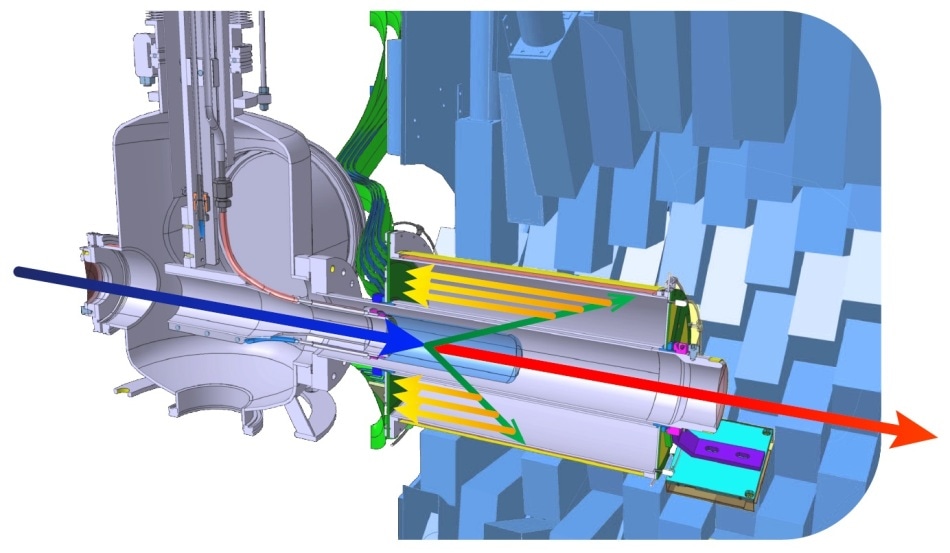May 16 2019
Scientists have come up with the first direct evidence for the existence of a rare type of atomic nucleus. The unique nickel nucleus (78Ni), which is an isotope of the normal nickel (58Ni), shares the same proton number but a different neutron number.
 An artistic rendering to visualize the landscape of isotopes. The purple line connects 78Ni with 238U, the substance from which researchers created their sample. (Image: © 2019 Bajo-kanna—with permission)
An artistic rendering to visualize the landscape of isotopes. The purple line connects 78Ni with 238U, the substance from which researchers created their sample. (Image: © 2019 Bajo-kanna—with permission)
In general, isotopes are rendered less stable by more neutrons, but this isotope is exceptional. When compared to other nickel isotopes that have similar numbers of neutrons, 78Ni is more rigid or tough—more energy is required to excite 78Ni into a different state.
Gravity holds huge things, such as planets, together, while electromagnetism holds smaller things, such as cats, together. Although these forces are very well known in day-to-day life, while delving deeper than the atomic level, it can be found that strong nuclear force holds nucleons, which are subatomic particles constituting the atomic nuclei, together. UTokyo researcher Ryo Taniuchi and coworkers explore precisely this subatomic realm.
A normal nickel atom includes 28 electrons, or negative charges, located around a nucleus consisting of 30 neutrons, or neutral nucleons, and 28 protons, or positively charged nucleons. Of all nickel in the world, 70% is like this. The disparity between protons and neutrons in nickel is directly proportional to its susceptibility to the destabilizing effect called beta-decay. However, despite that 78Ni has many more neutrons compared to normal nickel isotopes, it is more stable than most of them.
So what makes 78Ni so special and why is it so tough?
This is due to magic, but not the Harry Potter kind. In nuclear physics, magic numbers signify a number of neutrons or protons that are said to give rise complete shells inside the nucleus— structures that are highly robust compared to incomplete shells. The concept of these shells is slightly euphemistic since the topic is about the quantum domain in which the logic of day-to-day experience is not applicable. However, in this case, a complete shell relates to the nucleus’ strength. More energy is required to excite and destabilize nuclei that have complete shells.
Therefore, an atom with a magic number of protons will be more rigid compared to the one without the magic proton number. In the same way, an atom with a magic number of neutrons is also tougher compared to one without that number. By contrast, an atom with both magic numbers of protons and neutrons is termed doubly magic and is anticipated to be much tougher. Taniuchi and team showed that 78Ni is doubly magic, but this was very challenging.
As far as we’re aware 78Ni does not exist on Earth, so to study it we had to make some. To do this we had to break apart some heavy uranium, 238U, which is good for making neutron-rich nuclei. For this we used the powerful Radioactive Isotope Beam Factory (RIBF) at RIKEN in Japan.
Ryo Taniuchi, The University of Tokyo
Using RIBF, the researchers smashed 238U particles on a target to provoke an artificial fission (splitting) reaction. One of the products of the reactions was 78Ni. Moreover, instruments at RIBF also enabled them to investigate the sample they developed. The researchers achieved this by observing gamma rays (a type of radiation) from the excited 78Ni sample and recorded their properties. Here, Taniuchi and team searched for an indicative signature in the gamma-ray data to validate their hypothesis.
This was an extremely difficult task and took a long time, but it was worth it for my Ph.D. You need sufficient data to identify the doubly magic characteristic and we struggled to get that despite access to the world-leading accelerator facility, RIBF. After the experiment, colleagues from around the world helped analyze the data. Results suggest 78Ni is doubly magic, but also that the magic nature suddenly disappears in isotopes beyond 78Ni.
Ryo Taniuchi, The University of Tokyo
One might be surprised about what is so significant about 78Ni in the first place. Its occurrence may, in fact, be crucial in gaining insights into the origin of matter. Life may not have been possible without it.
“The Earth as we know it would not be the same without certain heavy elements, so it’s important to know where these came from. We know that many are made in supernova explosions—the death throes of giant stars—or even in collisions between neutron stars,” described Taniuchi. “There is strong reason to believe that 78Ni and unstable nuclei beyond play a significant role in this process—called nucleosynthesis. As a consequence of our discovery, researchers exploring this fascinating field can create better ideas about the origin of matter.”